Have you ever made a bucket of ceviche?
Or chopped onions on a moving boat?
Have you ever tasted limes that are the shape of lemons, but with a green and warty rind and flesh the color of a mandarin orange?
Have you ever had fresh ceviche? I mean really fresh, where you take a newly caught yellow fin tuna, still thrashing on the line, and turn it into the most delicious ceviche you could imagine?
If you have never done these things, it’s not too late. You just need the patience of a Galapagos fisherman and his crew, a beautiful day, and just a splash of luck.
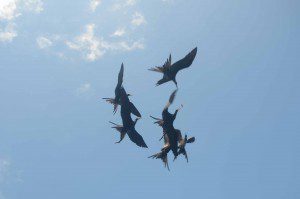 It seemed like hours that our small craft, The Tropical, cruised around the four small islands called Los Cuatro Hermanos just off the coast of Isla Isabela. But as we trolled for fish, we also explored the habitat of Blue-Footed and Nazca Boobies, fur seals, California sea lions, frigate birds, and more. It was hours for me, the non-fisherman, because the waters were a tad choppy and my handy-dandy anti-seasickness bracelets were on the verge of failing my weak stomach. Trying to take pictures of birds through a long lens only made the sensation worse. For those of you who suffer from sea-sickness, you’ll know that keeping your eye on the horizon is all important and a camera lens that tightly focuses on a single bird makes that all but impossible.
It seemed like hours that our small craft, The Tropical, cruised around the four small islands called Los Cuatro Hermanos just off the coast of Isla Isabela. But as we trolled for fish, we also explored the habitat of Blue-Footed and Nazca Boobies, fur seals, California sea lions, frigate birds, and more. It was hours for me, the non-fisherman, because the waters were a tad choppy and my handy-dandy anti-seasickness bracelets were on the verge of failing my weak stomach. Trying to take pictures of birds through a long lens only made the sensation worse. For those of you who suffer from sea-sickness, you’ll know that keeping your eye on the horizon is all important and a camera lens that tightly focuses on a single bird makes that all but impossible.
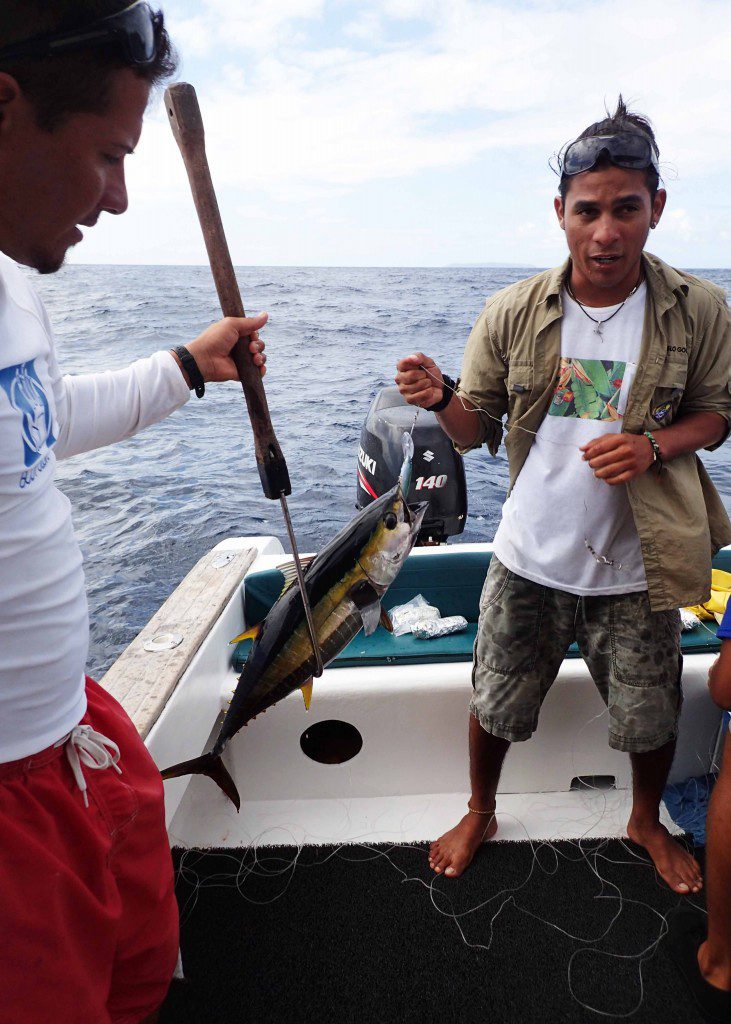 Just as we were about to give up and start the snorkel portion of our trip, our first mate, Joel, got a bite on the hand line. Slow but sure, he pulled in the catch, hand over hand, and his brother, Captain Vladimir, stuck the fish with a gaff. It was a gorgeous specimen, almost too beautiful to eat. I now understand where a yellow-fin tuna gets his name – from the metallic gold dorsal fins and smaller sharp that shine an unbelievably brilliant yellow in the equatorial sun. This fish was a stunner, a still-life painting right before our eyes.
Just as we were about to give up and start the snorkel portion of our trip, our first mate, Joel, got a bite on the hand line. Slow but sure, he pulled in the catch, hand over hand, and his brother, Captain Vladimir, stuck the fish with a gaff. It was a gorgeous specimen, almost too beautiful to eat. I now understand where a yellow-fin tuna gets his name – from the metallic gold dorsal fins and smaller sharp that shine an unbelievably brilliant yellow in the equatorial sun. This fish was a stunner, a still-life painting right before our eyes.
Lunch had been caught.
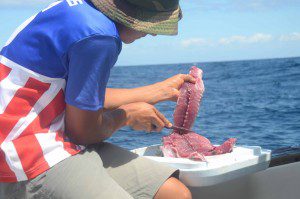 While we snorkeled, Joel filleted the fish, serving the guts and lesser parts to the horde of frigate birds hovering above the small boat. The captain took over and sliced the tender pale pink flesh into small, bite sized pieces. Each filet, once diced, ended up in a large blue bucket where Joel was squeezing the most beautiful orange-fleshed limes I have ever seen. He was ever so careful to not let a single seed fall into the marinating fish. Meanwhile, Andrea, our tour coordinator, was chopping tomatoes as if making a pico de gallo. Then she sliced red onions into a fine slivers, massaging them with a good portion of sea salt before adding them to the tomatoes. Then she diced a single green pepper and tossed into the mix. Finally, the vegetables received their own shower of fresh citrus juice.
While we snorkeled, Joel filleted the fish, serving the guts and lesser parts to the horde of frigate birds hovering above the small boat. The captain took over and sliced the tender pale pink flesh into small, bite sized pieces. Each filet, once diced, ended up in a large blue bucket where Joel was squeezing the most beautiful orange-fleshed limes I have ever seen. He was ever so careful to not let a single seed fall into the marinating fish. Meanwhile, Andrea, our tour coordinator, was chopping tomatoes as if making a pico de gallo. Then she sliced red onions into a fine slivers, massaging them with a good portion of sea salt before adding them to the tomatoes. Then she diced a single green pepper and tossed into the mix. Finally, the vegetables received their own shower of fresh citrus juice.
- Squeezing citrus juice for the bucket of ceviche.
- The Crew making Ceviche
- Dicing fresh tuna for a bucket of ceviche.
 Once the fish turned opaque around the edges, about 20 minutes or so, it was time to include the veggies. Plastic spoons churned the contents of the bucket until all the finally diced pieces of tomato and onion and green pepper were evenly distributed. The bucket of ceviche was ready.
Once the fish turned opaque around the edges, about 20 minutes or so, it was time to include the veggies. Plastic spoons churned the contents of the bucket until all the finally diced pieces of tomato and onion and green pepper were evenly distributed. The bucket of ceviche was ready.
We were handed four plastic spoons and half of the ceviche in a rectangular plastic container and told to have at it. A few plantain chips for crunch and we had the best ceviche of my life. From the sounds of the crew, their ceviche in the bucket tasted even better.
- A Crew Selfie with the Bucket of Ceviche
- Our Family Sharing a Bucket of Ceviche
- The Crew with Finished Ceviche


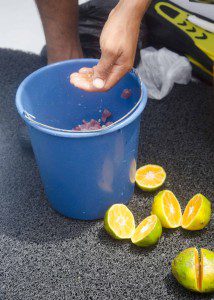
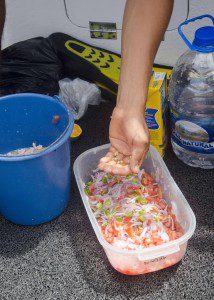
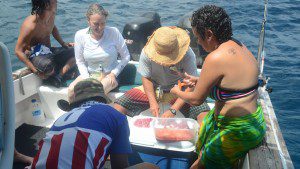
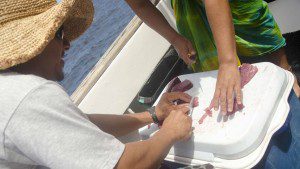
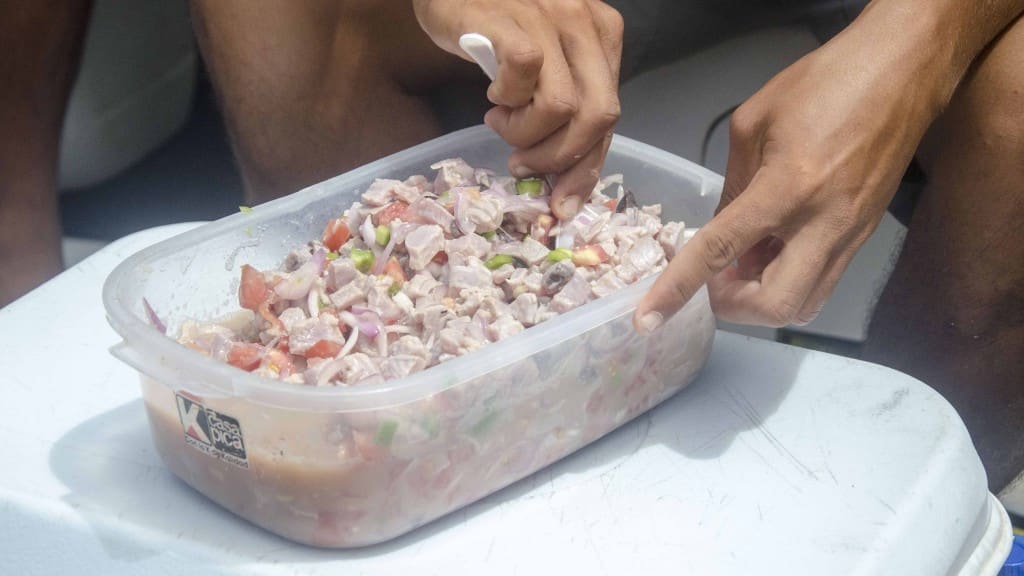

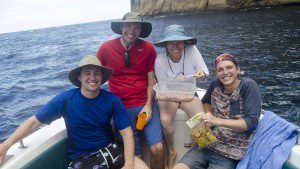
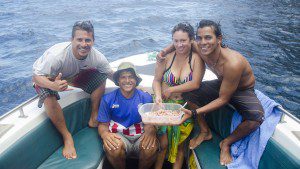









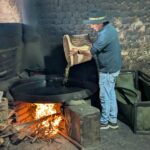


thank you http://www.refbitcoin.net
Yum! I can taste the freshness!
Yum!